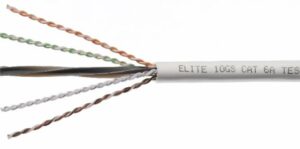 A newly popularized cable is Cat6a. It is the new “cable on the block” which has prolonged the life of copper cabling. Cat6a has the shielded twisted and untwisted pairs with different advantages and features. It supports Gigabit Ethernet up to a hundred meters. However, you need to understand and cope with several issues.
A newly popularized cable is Cat6a. It is the new “cable on the block” which has prolonged the life of copper cabling. Cat6a has the shielded twisted and untwisted pairs with different advantages and features. It supports Gigabit Ethernet up to a hundred meters. However, you need to understand and cope with several issues.
Contentions
The size of Cat6a cable is larger than Cat5e. Copper is inherently unreliable due to Bit Error Rates or BER. This is why manufacturers have designed Cat6a cables with a smaller cross-section. It takes up less space in the tray. Yet, this space is needed to minimize crosstalk between cabling pairs. The protective shield in Cat6a cable adds to the expense.
Electricity and Mechanical Facets
Aside from the electrical issues, Cat6a Untwisted Pair (UTP) is fabricated with bigger conductors. It has more rigid twists compared to Cat5e and Cat6 and these heavier conductors plus large and stiffer jacket combines to make for more difficult cable installation. Besides, the external diameter of the UTP means that the Cat6a cable takes up more room in the trays and conduits.
Electrical and mechanical issues should not be overlooked since this can affect performance. The physical stability of Cat6a is essential to its transmission performance. Cat6a can be more sensitive to degradation of signal compared to Cat5.
These may be produced by the following:
- Cable twisting generates signal reflection.
- Excess insertion pressure on cables can cause poor connector performance.
- Weakness of RJ45 (communications) connectors.
For example, if the cable is wedged in a door or compressed or squeezed by a heavy object, can result in sporadic network problems which may not be easy to detect. Nevertheless, Cat6a functions at enhanced specifications compared to Cat6 UTP. Considering all of these issues it may seem that fiber cable will become the ultimate future for 10 Gigabit Ethernet. It is up to users and the market forces to make the choice.

